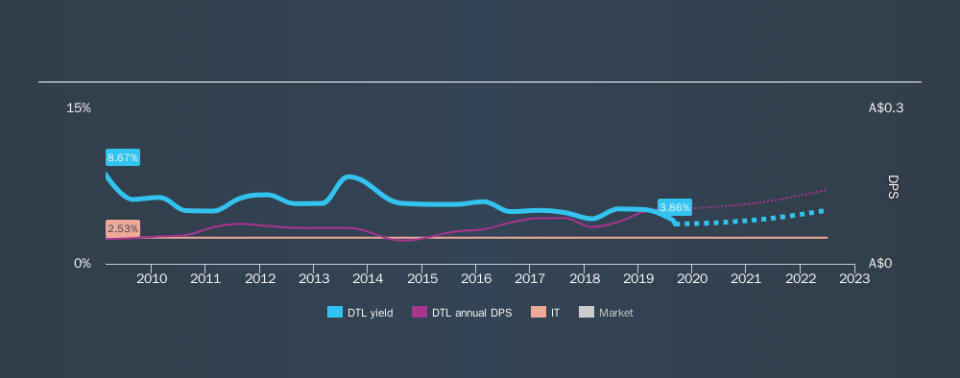Don't Race Out To Buy Data#3 Limited (ASX:DTL) Just Because It's Going Ex-Dividend

It looks like Data#3 Limited (ASX:DTL) is about to go ex-dividend in the next 4 days. Investors can purchase shares before the 13th of September in order to be eligible for this dividend, which will be paid on the 30th of September.
Data#3's next dividend payment will be AU$0.071 per share, and in the last 12 months, the company paid a total of AU$0.11 per share. Calculating the last year's worth of payments shows that Data#3 has a trailing yield of 3.9% on the current share price of A$2.77. Dividends are a major contributor to investment returns for long term holders, but only if the dividend continues to be paid. As a result, readers should always check whether Data#3 has been able to grow its dividends, or if the dividend might be cut.
View our latest analysis for Data#3
Dividends are usually paid out of company profits, so if a company pays out more than it earned then its dividend is usually at greater risk of being cut. Last year Data#3 paid out 91% of its profits as dividends to shareholders, suggesting the dividend is not well covered by earnings. Yet cash flows are even more important than profits for assessing a dividend, so we need to see if the company generated enough cash to pay its distribution. Over the past year it paid out 180% of its free cash flow as dividends, which is uncomfortably high. It's hard to consistently pay out more cash than you generate without either borrowing or using company cash, so we'd wonder how the company justifies this payout level.
Data#3 does have a large net cash position on the balance sheet, which could fund large dividends for a time, if the company so chose. Still, smart investors know that it is better to assess dividends relative to the cash and profit generated by the business. Paying dividends out of cash on the balance sheet is not long-term sustainable.
Cash is slightly more important than profit from a dividend perspective, but given Data#3's payouts were not well covered by either earnings or cash flow, we would be concerned about the sustainability of this dividend.
Click here to see the company's payout ratio, plus analyst estimates of its future dividends.
Have Earnings And Dividends Been Growing?
Companies with consistently growing earnings per share generally make the best dividend stocks, as they usually find it easier to grow dividends per share. Investors love dividends, so if earnings fall and the dividend is reduced, expect a stock to be sold off heavily at the same time. Fortunately for readers, Data#3's earnings per share have been growing at 19% a year for the past five years. It's not encouraging to see Data#3 paying out basically all of its earnings and cashflow to shareholders. We're glad that earnings are growing rapidly, but we're wary of the company stretching itself financially.
Many investors will assess a company's dividend performance by evaluating how much the dividend payments have changed over time. In the last 10 years, Data#3 has lifted its dividend by approximately 8.3% a year on average. It's encouraging to see the company lifting dividends while earnings are growing, suggesting at least some corporate interest in rewarding shareholders.
The Bottom Line
Has Data#3 got what it takes to maintain its dividend payments? Earnings per share have been growing, despite the company paying out a concerningly high percentage of its earnings and cashflow. We struggle to see how a company paying out so much of its earnings and cash flow will be able to sustain its dividend in a downturn, or reinvest enough into its business to continue growing earnings without borrowing heavily. It's not that we think Data#3 is a bad company, but these characteristics don't generally lead to outstanding dividend performance.
Ever wonder what the future holds for Data#3? See what the two analysts we track are forecasting, with this visualisation of its historical and future estimated earnings and cash flow
If you're in the market for dividend stocks, we recommend checking our list of top dividend stocks with a greater than 2% yield and an upcoming dividend.
We aim to bring you long-term focused research analysis driven by fundamental data. Note that our analysis may not factor in the latest price-sensitive company announcements or qualitative material.
If you spot an error that warrants correction, please contact the editor at editorial-team@simplywallst.com. This article by Simply Wall St is general in nature. It does not constitute a recommendation to buy or sell any stock, and does not take account of your objectives, or your financial situation. Simply Wall St has no position in the stocks mentioned. Thank you for reading.

 Yahoo Finance
Yahoo Finance 
